We are going to the Bolivian desert which is at high altitude being between 4,800m and 3,400m (14,600ft – 11,400ft). This involves clearing Immigration and Customs in San Pedro in Chile and then driving 40km into the high desert to the Bolivian border. There is a queue to clear Chile of about 50 people as there is only one official and probably only one stamp.
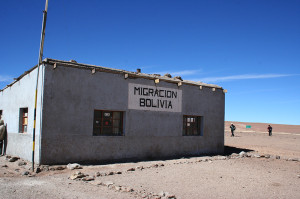 At the Bolivian border there is a melee of people and cars because everyone has to change vehicles. The Bolivians don’t like Chilean vehicles in their country probably because they work. We have heard lots of tales of cars breaking down in the desert, of flat tyres being inflated up with bicycle pumps and 4x4s being crammed with up to 8 people. However, in our car there are only 4 of us: James, Debbie, our guide Edgar and a driver. Bolivian luxury.
At the Bolivian border there is a melee of people and cars because everyone has to change vehicles. The Bolivians don’t like Chilean vehicles in their country probably because they work. We have heard lots of tales of cars breaking down in the desert, of flat tyres being inflated up with bicycle pumps and 4x4s being crammed with up to 8 people. However, in our car there are only 4 of us: James, Debbie, our guide Edgar and a driver. Bolivian luxury.
As the early morning passed 4×4’s start to disappear off into the desert. The vehicles are laden with people, backpacks, boxes of simple foods, a spare wheel (hopefully), fuel, water (for the radiators) and a variety of MP3s/iPODs plugged into the dashboards playing all manner of music. The better cars had quality western music, others Bolivian pan-pipes and artistes – unfortunately that included our car. The journey itself tries the spirit and the body, the entire 3 days is spent with our bodies moving in different directions, sometimes our heads hit the roof, other times we become closely acquainted with the windows. Debbie’s view is that it is the most physically uncomfortable journey she has ever taken!
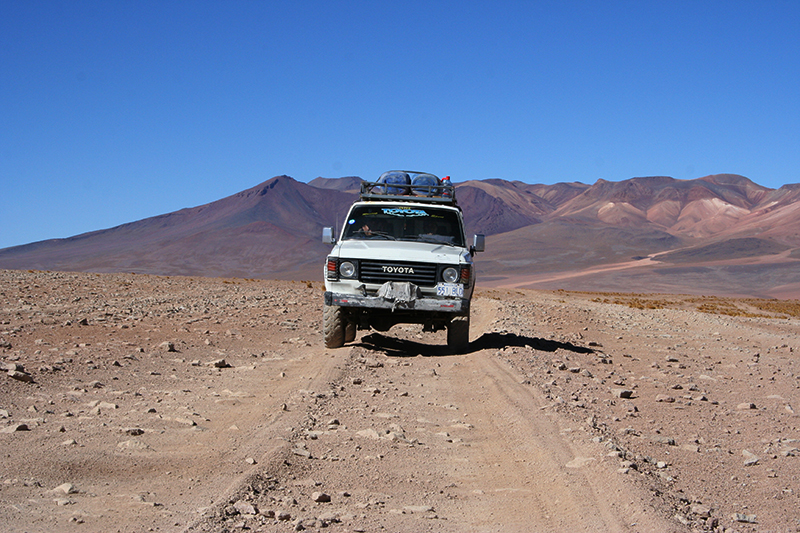 However for the drivers who make this journey frequently it’s a chance to have some fun. Our driver, a real space cadet, tries to race his mates from time to time and, on balance, I would prefer it if he didn’t practice for next year’s Dakar Rally on our time. Despite his efforts we get passed by loads of 4x4s, no doubt egged on by those on-board as this is a popular route particularly with backpackers.
However for the drivers who make this journey frequently it’s a chance to have some fun. Our driver, a real space cadet, tries to race his mates from time to time and, on balance, I would prefer it if he didn’t practice for next year’s Dakar Rally on our time. Despite his efforts we get passed by loads of 4x4s, no doubt egged on by those on-board as this is a popular route particularly with backpackers.
The desert itself has no roads simply a series of dirt tracks complete with corrugations, dips, bumps and large stones. There are numerous wheel tracks all around as drivers try to avoid the worst of the ‘road’ and as you try to settle down into the ‘washing machine’ ride you start to see the incredible beauty of the environment around you.
The most amazing aspect of this desert is how it manages continually to transform itself. Out of nowhere the scenery changes completely. We move from Volcanoes to sand to lakes to springs to rock in a single jolt of the car. It is all so different that it does not seem possible that we are in the same place.
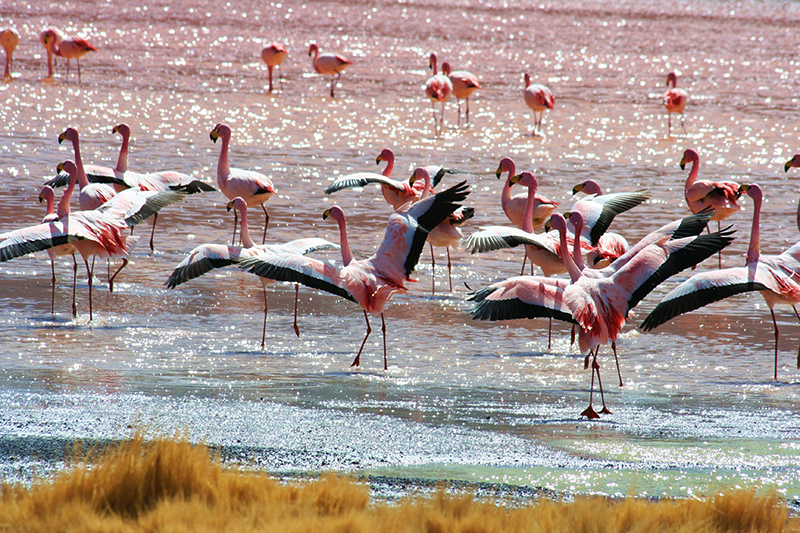 Firstly there are a number of lagoons and salt lakes (that is salt as in the chemical term). Most are Borax on which large numbers of Flamingos spend their time feeding off shrimp. Two are very different, Laguna Verde is sulphur, where nothing can live in its watery slush as it is laden with arsenic but its vibrant colour stands out next to its white neighbour, Laguna Blanca both at the foothills of Volcano Licancabur (5,868m). Laguna Colorado (4,270m) is red as a result of the type of algae that thrive in it and there are a huge number of flamingos (including the rare James Flamingo) that are perfectly camouflaged against the salts. One of the lakes was fed by some hot springs which offered Debbie an opportunity to take a swim in 36c at 4,800m. The highest bath she has experienced, though climbing out into the cold air was a contrast she did not enjoy!
Firstly there are a number of lagoons and salt lakes (that is salt as in the chemical term). Most are Borax on which large numbers of Flamingos spend their time feeding off shrimp. Two are very different, Laguna Verde is sulphur, where nothing can live in its watery slush as it is laden with arsenic but its vibrant colour stands out next to its white neighbour, Laguna Blanca both at the foothills of Volcano Licancabur (5,868m). Laguna Colorado (4,270m) is red as a result of the type of algae that thrive in it and there are a huge number of flamingos (including the rare James Flamingo) that are perfectly camouflaged against the salts. One of the lakes was fed by some hot springs which offered Debbie an opportunity to take a swim in 36c at 4,800m. The highest bath she has experienced, though climbing out into the cold air was a contrast she did not enjoy!
On the way through we meander past ‘cinco lagunas’ a chain of small, flamingo-speckled lagoons – Ramaditas, Honda, Chiarcota, Hedionda and Canapa – that offered a perfect picnic spot for lunch even though every 4×4 passing through seemed to pick the same spot! The lagoons all lie in the vastness of Volcano Ollague where the Chilean/Bolivian boarder runs through the middle. The unusual lava formations that flow from the volcano are all on the Bolivian side – no doubt an omen.
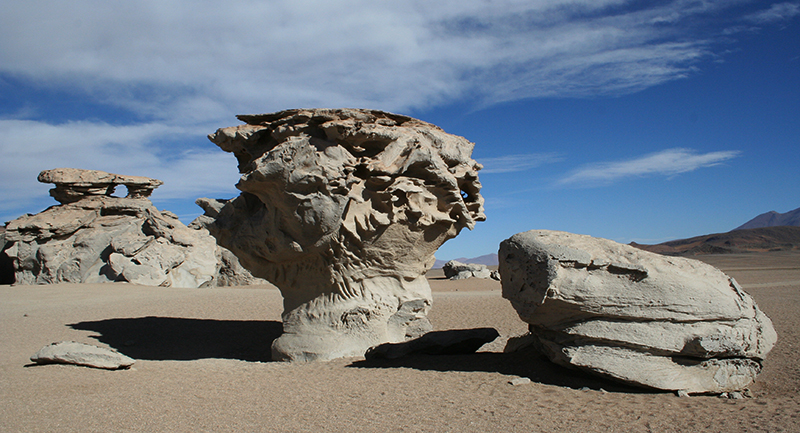 There are other desert delights to enjoy: The Dali Desert where it is claimed that he took inspiration for a number of his paintings; The Arbol de Piedra, an odd shaped rock that looks something like a tree: the Sol de Manana geysers at in the crater an old volcano that sprout both boiling water and molten larvae and smells horribly of rotten eggs.
There are other desert delights to enjoy: The Dali Desert where it is claimed that he took inspiration for a number of his paintings; The Arbol de Piedra, an odd shaped rock that looks something like a tree: the Sol de Manana geysers at in the crater an old volcano that sprout both boiling water and molten larvae and smells horribly of rotten eggs.
Much of the surrounding beauty is that many of the volcanoes are multi coloured as they contain several minerals that have oxidised over the millennium and they provide a border to the scenery that is surreal and very striking.
The desert hotels are something of a mixture: There are some dreadful ones but these are highly desirable compared to the hostels that are on offer to the backpackers (Lauren – take lots of warm clothes and water!). The first day ends at the Hotel del Desierto. This is almost civilised, it has hot water that disappears as soon as it starts to come through and you could run round in the shower without getting wet. The hotel was at 4,800m (15,600) making the place very very cold (especially at night), windy and a bit depressing. Sven woke up in the early hours of the morning suffering from the altitude; short of breath and with a headache. Unfortunately, much of that was due to lack of water, none was provided on the way and so we had to resort to sterilisation tablets. The second hotel was a great improvement – hot water, warm beds and a lovely open log fire in the middle of the dining room. Despite this it was still very cold, very windy and the food exactly the same as the night before – rice, quinoa, tough beef and omelette. We didn’t starve!
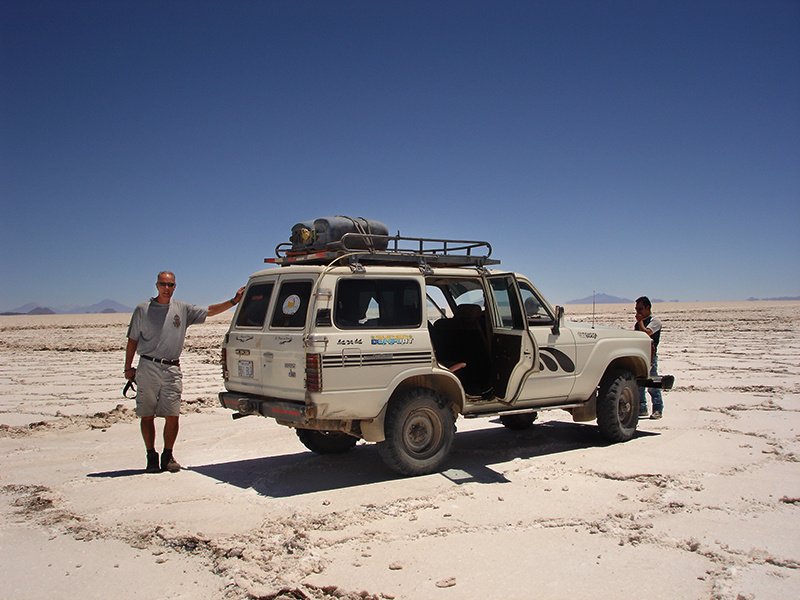 Having travelled for 2 days we finally reached the highlight of the trip – the Salar de Uyuni. It is the largest and the highest salt flat in the world covering 12,000 sq Km at an altitude of 3,660m. Salt Lake in USA is next and third in size is Salar de Atacama. 12,000 years ago this whole area was under water. Crossing the salar is one of the great drives of the world, a fantastic experience when the bright blue skies contrast with the blinding white salt crust. Having looked forward to this part of the trip with great anticipation, our first views were very disappointing. The reason being is that the first salt flat you come to is the Salar de Chiguana which is not flat white salt at all but lumpy and dirty. Fortunately, it doesn’t take long to cross and then the white expanse is just truly blinding. We spent the day driving across, briefly trying to help out a stranded lorry. A visit and lunch at Isla Incahuasi is weird sensation because you literally ‘drive’ up to this island. It is a coral island that has been raised up from the ocean bed and covered in tall cacti and offers walking trails with superb 360degrees views of the salt flat.
Having travelled for 2 days we finally reached the highlight of the trip – the Salar de Uyuni. It is the largest and the highest salt flat in the world covering 12,000 sq Km at an altitude of 3,660m. Salt Lake in USA is next and third in size is Salar de Atacama. 12,000 years ago this whole area was under water. Crossing the salar is one of the great drives of the world, a fantastic experience when the bright blue skies contrast with the blinding white salt crust. Having looked forward to this part of the trip with great anticipation, our first views were very disappointing. The reason being is that the first salt flat you come to is the Salar de Chiguana which is not flat white salt at all but lumpy and dirty. Fortunately, it doesn’t take long to cross and then the white expanse is just truly blinding. We spent the day driving across, briefly trying to help out a stranded lorry. A visit and lunch at Isla Incahuasi is weird sensation because you literally ‘drive’ up to this island. It is a coral island that has been raised up from the ocean bed and covered in tall cacti and offers walking trails with superb 360degrees views of the salt flat.
The final stop to our 3 days in the desert is the Salt Hotel which is no longer open to guests due to contamination, so it now rests as a mausoleum to some fun that people must have had in the past. Being the final ‘stop-off’ point before reaching Uyuni there are several cars around and quite soon it became apparent that the drivers and guides were not happy and clearly bothered by something. Being tourists we ignored this for a while and pottered around taking photos. The concern became one that affected us all because the news the guides were getting was that Uyuni was ‘closed’ and we would not be able to get into town due to road blocks all the way around. Those without jobs (unemployment in Bolivia runs at 60%) had blockaded the town in protest at the lack of employment opportunities. By all accounts a fairly common occurrence. Trains and buses out of town were cancelled and small vehicles like taxis and mini-vans were supporting the blockade by nimbly cutting off routes that the larger lorries couldn’t get to. With Dunkirk spirit, or the Bolivian equivalent, we drove out of the salt flats, towards the surrounding farmland and hills, crossing fields and river beds, through construction sites and piles of rubbish to get to the town square being guided around the blocks by someone in town via mobile.
Because no-body could get in, no-body could get out so the small town was awash with backpackers milling around and tourists wandering aimlessly wondering what to do. We were offered, at considerable expense, a 4×4 to drive us to Oruro, a town about 250km further north. As with most problems, if you throw enough money at it ‘something can be arranged’. Thus, for the princely sum of US$250 in Bolivians we ended up taking a 6 hour car journey to get out of town. The first hour being a repeat of our arrival, dodging road blocks and trying to outtrun cars that were trying to head us off. One poor farmer, whilst trying to herd his llama into their pen, had our car drive round his small land-holding twice before Edgar (our guide cum driver) asked for directions off his land! However, our bodies and mind were so tired from 3 days in the car that somehow another 6 hours seemed nothing. The tragedy is that not only is the desert road-less, there are no roads in Bolivia south of Oruro, the roads are unpaved dirt tracks, with huge gullies and crevices that the car has to negotiate. We tumbled into Oruro at midnight, fell into a hotel and slept like we hadn’t had any sleep in days.

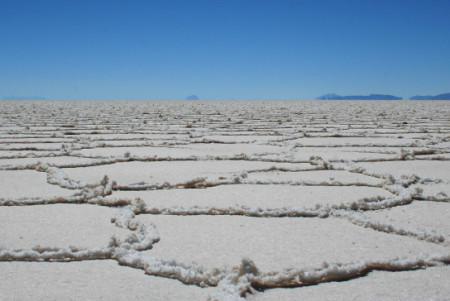
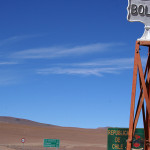
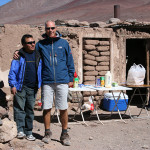
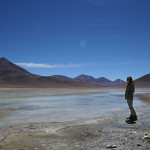
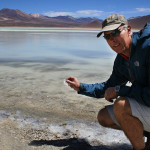
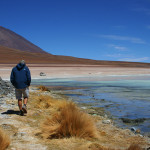
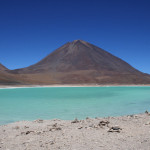
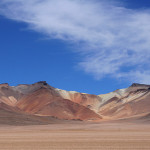
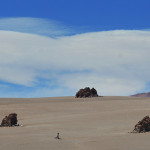
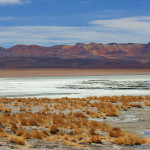
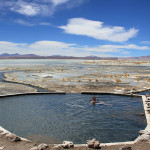
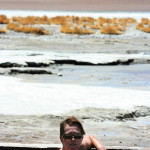
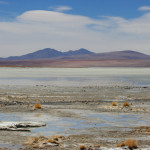
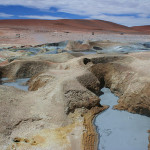
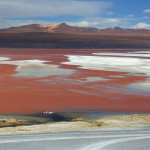
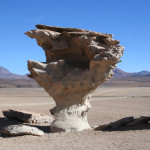
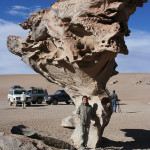
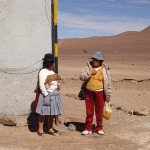
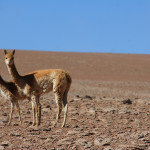
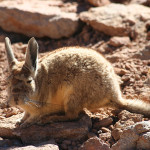
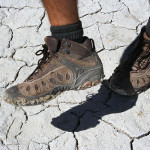
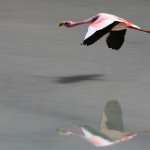
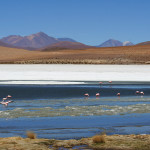
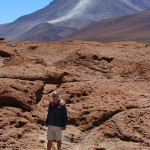
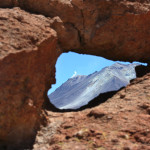
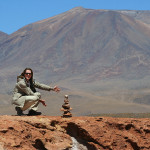
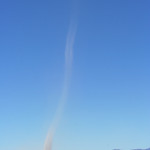
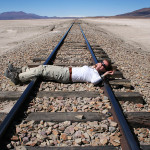
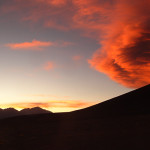
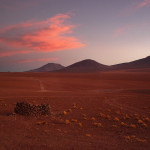
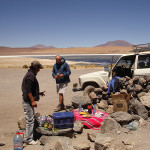
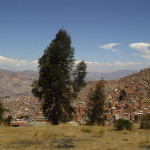
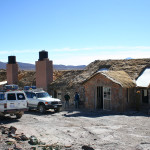
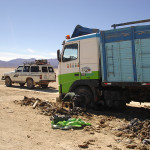
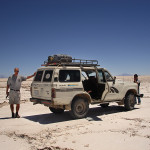
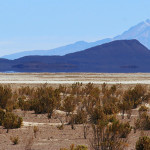
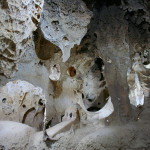
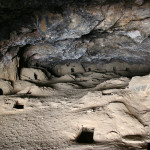
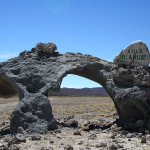
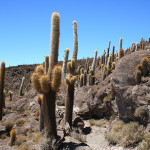
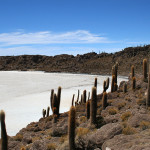
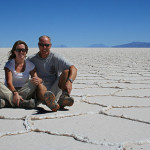
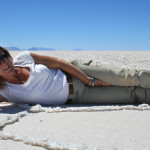
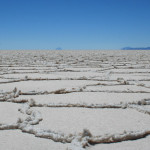
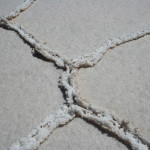
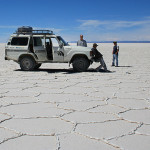
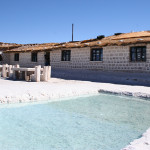
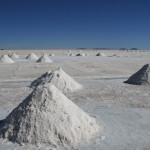
No comments yet.